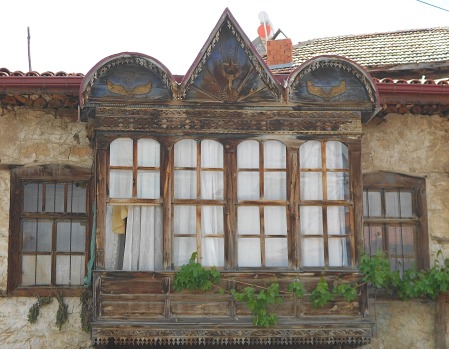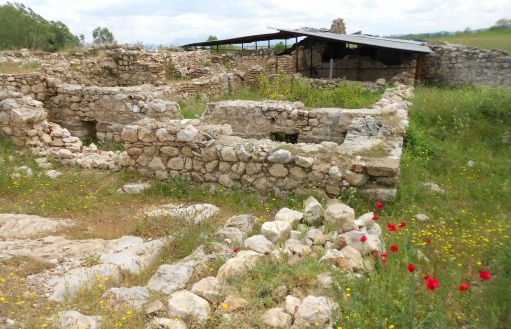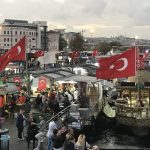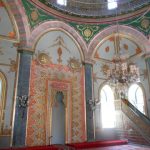Gölyaka is one of those places you sometimes come across in Turkey that has the feel of the end of the world about it. The main road is lined with mud-brick and stone houses with pretty jutting-out cumbas (bay windows) but as we drive along its wide empty space there’s no getting away from the fact that there are no cars and only a very few people wandering about. Just a little way ahead of us is Kubadabad where the Selçuks built their summer palace above the shores of Lake Beyşehir in the 13th century. Otherwise, there’s no reason for anyone to come here and so they don’t.
The ruins of the palace stand in a location of almost inestimable beauty. This is not the soaring grandeur of the eastern end of the Black Sea, nor yet the crazy, mixed-up volcanic landscape of Cappadocia. Instead it has the peaceful, calming beauty of the lake-and-mountain combination that turned Switzerland into one of the world’s tourism hotspots. Yet here I stand, knee-deep in wildflowers, amid the ruins of what should be one of the country’s best-known archaeological sites, and I’m alone but for the skylarks, Dursun, my taxi driver, having driven back to Gölyaka to pray.
It was Sultan Alaadin Keykubad, one of the greatest of the Selçuk rulers, who had the palace built for himself in 1235, hoping no doubt to escape the great heat of his capital, Konya, in the height of summer. Yet the ruins of his palace barely merit the effort of labelling them as far as the authorities are concerned. This is the Küçük Saray (Small Palace) and this the Büyük Saray (Big Palace) is all they have to tell me. The grass has been cut inside the Büyük Saray recently. Otherwise the site feels as forgotten as Gölyaka itself.
It’s silent here, the wonderful silence that, these days, sometimes seems the most priceless prize of all. There’s just the faint whoosh of wind on water, the occasional chiding call of a cowherd to his beasts, the screech of the odd diving tern and the warble of the skylarks. In front of me stretches a vista of reed-beds, then jade-coloured water, then distant mountains still vaguely snowcapped. Behind me soars Aramaz Dağı, its peak as sharp and daunting as its name (“It can’t be passed”).
I wander the ruins but can make little sense of what I’m seeing. In places the walls still stand to a considerable height. In one place, too, I find a stretch of terracotta-tiled drainage channel, in another a Roman gravestone reused as masonry. But the story of the buildings is as lost in the mists of time as the Selçuks themselves. Alone here, though, my imagination is free to take wing. Is that a camel caravan making its wavering way towards me, as the animals arrive, finally, on the long road from Konya along which I whizzed so carelessly by bus just one day earlier? Before the remains of a gate I see them kneeling, spitting and grunting as their drivers help the sultan down, then start unloading carpets of jewel-like magnificence from their backs.
This being Turkey it goes without saying that the “improvements” made to the site are also the worst eyesores: a hideous toilet box and the huge concrete house built for the benefit of archaeologists who would surely have preferred something more in keeping with the surroundings. Worse still is the newly laid access road from Gölyaka, which some bright spark in Beyşehir decided should be laid with cobbles that make for a spine-jarringly rough ride.
The road back to Beyşehir passes through Gölkonak where I stop with Dursun for a glass of tea. “The men here are bone idle,” he’s already said to me. “Sitting about in the teahouse while the women do all the work.”
“Perhaps they’re retired,” I say, startled to hear from the lips of a Turk an opinion that is much more frequently uttered by tourists.
He’s having none of it. “Lazy!’ he repeats. “The women work all day. It’s not like this in Beyşehir.” Where he comes from, of course.
In Gölkonak they’re mourning the premature death of the muhtar’s wife and are keen to press commemorative bread and helva on us – until they find that it’s run out. “I saw you taking a picture earlier,” says one of the men. “What were you doing?”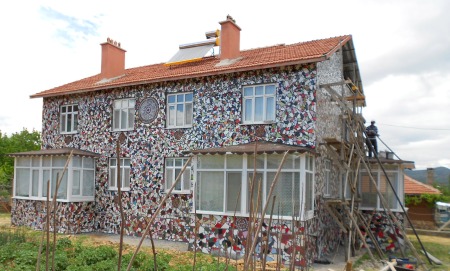
Ah. The Hansel and Gretel house. Here in this tiny out-of-the-way village someone has decided to cover the entire surface of their house with brightly coloured mosaics, and I think once again how odd it is that the Turks, so conformist in many things, are yet so annoyingly individualistic when it comes to the horrors they insist on inflicting on their neighbours.
On we press to Kurucuova where, again, the men are idle according to Dursun (“Maybe we should rename it Tembelköy (Lazy Village),” I suggest to nervous tittering) and where, once again, we pause for tea at the express command of a teahouse occupant who says accusingly that he’d seen us pass through without stopping earlier. This, too, is a tiny village, its population so small now that it is to be deprived of its Belediye (local council) even though that means that all future official business will have to be transacted 55 kilometres away in Beyşehir. It’s an economy I entirely understand. How can the government continue to provide a full coterie of civil servants in a such a remote outpost? Yet once it’s removed it can surely only serve to accelerate the emptying-out of the village that is already so evident.
But the men have happier topics on their minds. “Did you tell her about the picnics to the islands?” asks one of them and Dursun nods, having already explained about the many fibreglass canoes lying seemingly abandoned in the fields but which, come summer, will fill up with happy families heading out on the lake for alfresco meals.
As we leave the village we pass a field full of donkeys. “They’re used to pull carts for bringing wood from the fields,” says Dursun and, sure enough, such a cart crawls past us, followed in short order by a woman riding a donkey just as women used to do in Göreme where I live.
The road meanders on, supposedly closed to traffic because of road widening, although since it’s Friday the huge Caterpillars stand as idle as the men in the teahouse by the road. Once we stop so that I can admire the view and Dursun can smoke a cigarette. A few cows are down by the waterside drinking but when we get close enough for me to snap them we come upon an enormous flock of goats nibbling its way through the bushes. A big white Kangal-cross of a dog warns us off and the shepherd rushes to control it. “How many goats do you have?” I ask his wife. “About 150,” she says. Their kids are up on the hillside apparently.
This is a world in which nature rules the roost. In the shallows a heron stands poised to strike. Little egrets stalk the flats. White water-lilies are on the verge of blossoming. From time to time we slow to a crawl to accommodate the cattle that treat the road as their own. 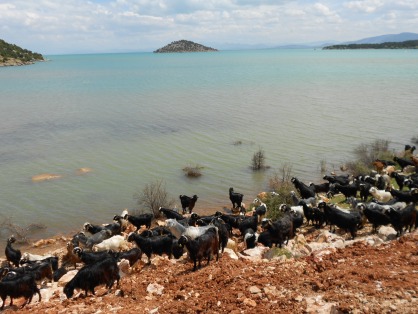
Then we come back to Yeşildağ, a slightly bigger town with an outsize modern mosque and lots of beautiful old stone houses with decorative wooden cumbas. Dursun says he’s looking for old houses for me to photograph but since his idea of something worth looking at is the row of nasty plaster storks adorning the nasty concrete “tree” arching over the entrance to the Belediye, I park him in the teahouse while I take a whip round on my own. Later I ask a tea-drinker if there’s a local name for the cumbas. “We used to call them sundurmas (penthouses) but now we just say balkons (balconies),” says one man.
“No, we used to call them kules (towers),” cuts in his friend. “Anyway, they’re all being pulled down now.”
Which is why, of course, I want to take pictures of them, before they’re all gone. But Yeşildağ’s main claim to local fame is its Leylek Vadisi (Stork Valley) which turns out to be something of a misnomer given that the storks actually nest in the local cemetery. We wander into the cemetery and while Dursun stops to pray for the deceased I roam amid the junipers, snapping storks living in triplex-style nests so large you wonder they don’t topple to the ground. It’s a place of wonder, silent again, but for the twittering of goldfinches and the strange clattering sound made by returning storks as they greet their mates on the nests. From time to time I feel the sun briefly blotted out as the shadow of a stork coming into land passes over me, legs trailing.
It’s hard to believe I could have missed somewhere as magical as the western shore of the lake but previous visits to Beyşehir always had to be condensed into rushed day trips because of the absence of any even halfway decent accommodation. Now, though, the comfortable Ali Bilir Hotel more than makes up for that failing making it possible to linger.
But – and it’s a big but – the road is already being widened which can only mean that the authorities intend that Kubadabad should become more accessible. For some time to come what is now a gloriously tranquil rural road is likely to be rendered noisy and dusty as the roadsides are grubbed up to make space for more cars. For the time being there’s no roadside litter, no ugly concrete restaurants with their names scrawled on the walls in black paint. But the writing is on the wall. A new road from Antalya will put Beyşehir within one hour’s drive of the tourism hotspots. The Selçuks were here in the 13th century and soon tout Turkey will be too.
Written: 4 August, 2013
